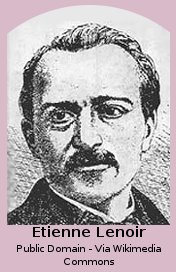Human Intelligence
Derives Rotary Motion From Explosion
Part 22 - Part 21
Thought Comes First
From the fertile fields, of Human Intelligence,
the embryo of the Internal Combustion Engine appears to have germinated
in the Mind of French Abbot and Inventor, one Jean de Hautefeuille,
(1647-1724) when he proposed using gunpowder as a fuel source to power a
machine to pump water.
What he described were the Fundamental Principles of the Atmospheric Gas Engine. He was not alone with his Thoughts of an Internal Combustion Engine.
Just Another False Start
The man who gave the Human race accurate time, via the Pendulum Clock, Christiaan Huygens,
experimented with the idea of using gunpowder as the fuel source to
drive rotary motion, around the same time, the latter quarter of the
17th century.
Huygens constructed a primitive working model
burning gunpowder to create a Vacuum and utilizing Atmospheric Pressure
to drive a Piston in a Cylinder.
Dennis Papin attempted to develop Huygen's model but found the technical hurdles far too great and turned his attention to Steam.
Too Darn Dangerous
Using gunpowder as a fuel source proved to be simply too dangerous. Complex difficulty in controlling the rate of burn simply added to the danger at the time.

Abandoned in favor of Steam, the concept of the Explosion Engine lay dormant for more than one hundred years.
Once
again, in common with superficial investigation, of a new Discipline,
suffered by Concepts and Ideas throughout History, Human intelligence
was laid aside. Effectiveness of Follow through neglected.
Almost
a century and a half following those brief dalliances with gunpowder,
Francois Isaac de Rivaz, (1752-1828) a French Politician, contrived a
Hydrogen Gas driven Engine.
Hydrogen Gas, as a fuel source,
suffered the above fate of being laid aside, by the majority of
Engineers, until recent times. Hydrogen Gas, is a fuel that may well be
the savior of the modern Auto Industry. German born Engineer and
Inventor Rudolf Erren was a notable exception, focusing his attention on
the benefits that Hydrogen offers.
Feel The Power
To get a feel for the inherent power of the internal combustion process, imagine a Cannon firing a ball. Cannons employ the same principles as the internal combustion engine.

For the purpose of an Engine that could perform work, the linear projection of the cannon ball required to be harnessed and converted into rotary motion.
This action is what the 'free piston' engine of Nikolaus Otto achieved. In reality though, it's behavior was still too much a canon.
Cannon maybe . . .
But It Worked
Jean-Joseph Lenoir, (1822-1900), a Belgian born Engineer, and Inventor, residing in Paris, introduced during 1860, the first Internal Combustion Engine that sold in quantity.

Powered by Coal Gas ignited via an Electric Spark, employing an
uncompressed Two Stroke configuration, Lenoir's Engine was an
inefficient, unreliable affair prone to severe overheating. Albeit, it
was easy to start, quiet and smooth running.
With little to no
choice available, out of desperation for a smaller self contained power
source Industry purchased Lenoir's engine.
The implementation of
this Engine, by Industrial users, provided the opportunity to prove that
internal combustion worked, and had a future.
Endeavors, by a variety of enterprising entities to commercialize small engines as a versatile power source, simply failed.
Clear Thinker
This was the machine that attracted, and held, the earnest attention of Nicolaus August Otto. (1832-1891) German Merchant, Clear Thinker, and yet to be, Inventor and Engineer.

Possessing an abiding passion for all things mechanical, he was inspired to believe he could improve on Lenoir's efforts.
To
this end Otto experimented by himself until he settled on his own
interpretation of what an Atmospheric Explosion Engine should be.
With
Otto's engine the explosion would produce a Vacuum and the Atmosphere
would then act on a piston, generating usable Power. This perception
indicated Otto understood the Natural Laws involved in much the same way
as Christiaan Huygens and Jean de Hautefeuille, had envisaged.
In a smooth, seamless display of Human intelligence, Otto fabricated a working model, obtained Patents, and last but not least, went scouting for a commercial partner.
This search terminated in finding the perfect man.
This man was talented, with a Cooperative Attitude, and who had the foresight to see that the Internal Combustion Engine was to be the future of Motive Power.
Sound Relationship
Otto formed a Limited Company. And the man he found, Eugen Langen, (1833-1895) a fellow German, Engineer, savvy Investor and an Inventor in his own right, became an active shareholder.

As well as providing his inventive and engineering skills to their new company, Langen also provided much needed funding.
With this funding in place the pair were ready for action.
Eugen Langen remained the fund raiser and an active partner throughout the lifelong Sound Relationship that followed. And within which the two men forged a flourishing friendship.
Langen And Otto partnered with the very deliberate intention of collaborating to manufacture a durable, efficient, small coal gas powered engine.
Small, relative to Steam Engines of the day.
Such
were these humble beginnings of the entity that would grow and expand
to become the Gasmotoren-Fabrik Deutz AG, known today simply as, Deutz
AG, operating in more than 130 Countries.
Free To Use Human Intelligence
Langen's funding paid for Otto's Patents to be transferred to their new company, pay out loans he had borrowed, to continue his development work, furnish him with a monthly wage, and provide a modest sum for working capital.

Relieved of monetary burden, Otto was free to dedicate his Mental
Powers, otherwise known as Human Intelligence, to improving their new
Engine.
The usual obstacles course, with which we are becoming familiar, hounded their partnership.
None
the less, in common with fellow Humans in possession of a lucid
comprehension of how their Mind works, obstructions failed to defeat
their determination, and the two men prevailed.
Everything else
aside, the Machine the pair Created proved to be so economical to
operate, it attracted a Gold Medal at the Paris Exhibition of 1867.
Consuming
barely thirty percent of the volume of it's closest rivals, Otto and
Langen's Engine aroused interest that every manufacturer must dream of.
Orders for this anticipated Machine flooded in from all over Europe, and
from abroad.
The arduous journey was far from over though. But sage Human intelligence will take care of the future.
At least taking care of the Future is an available option . . .
Human Intelligence Rocks!
Part 22 - Part 21
Next - Clear Thinking





